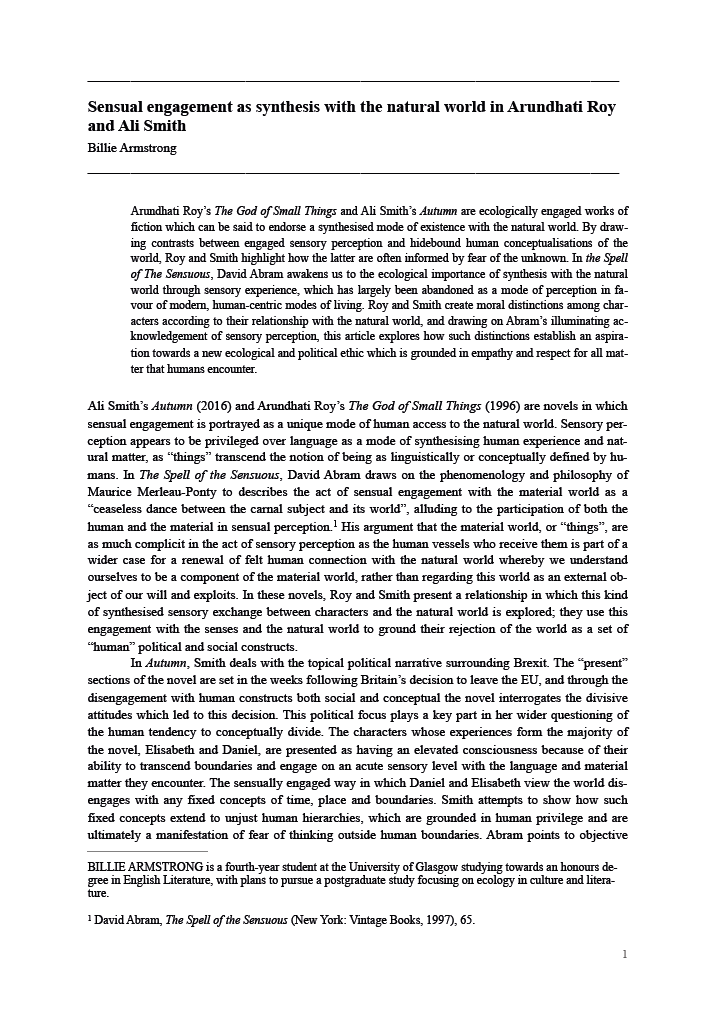Sensual engagement as synthesis with the natural world in Arundhati Roy and Ali Smith
DOI:
https://doi.org/10.36399/GroundingsUG.11.168Keywords:
Arundhati Roy, Ali Smith, Sensual Engagement, Synthesis, Natural WorldAbstract
Arundhati Roy’s The God of Small Things and Ali Smith’s Autumn are ecologically engaged works of fiction which can be said to endorse a synthesised mode of existence with the natural world. By drawing contrasts between engaged sensory perception and hidebound human conceptualisations of the world, Roy and Smith highlight how the latter are often informed by fear of the unknown. In the Spell of The Sensuous, David Abram awakens us to the ecological importance of synthesis with the natural world through sensory experience, which has largely been abandoned as a mode of perception in favour of modern, human-centric modes of living. Roy and Smith create moral distinctions among characters according to their relationship with the natural world, and drawing on Abram’s illuminating acknowledgement of sensory perception, this article explores how such distinctions establish an aspiration towards a new ecological and political ethic which is grounded in empathy and respect for all matter that humans encounter.
References
Abram, David. The Spell of the Sensuous. New York: Vintage Books, 1997.
Antonio, D. “The flesh of all that is: Merleau-Ponty, Irigaray, and Julian’s ‘showings’,” Sophia 40, no. 2 (2001): 47–65.
Ashbaugh, Anne Freire. “The Philosophy of Flesh and the Flesh of Philosophy,” Research in Phenomenology 8 (1978): 217–223. JSTOR, JSTOR, www.jstor.org/stable/24654297.
Merleau-Ponty, Maurice. The Visible and the Invisible. Translated by Alphonso Lingis. Illinois: Northwestern University Press, 1968.
Roy, Arundhati. The God of Small Things. London: Flamingo HarperCollins, 1997.
Smith, Ali. Autumn. London: Penguin Books, 2017.

Downloads
Published
Issue
Section
License
Copyright (c) 2018 Billie Armstrong

This work is licensed under a Creative Commons Attribution 4.0 International License.
The CC BY 4.0 license is a Creative Commons license. This is a non-copyleft free license that is good for art and entertainment works, and educational works. It is compatible with all versions of the GNU GPL; however, like all CC licenses, it should not be used on software. People are free to: Share — copy and redistribute the material in any medium or format; Adapt — remix, transform, and build upon the material for any purpose, even commercially. The licensor cannot revoke these freedoms as long as you follow the license terms. But they must conform to the following terms: Attribution — You must give appropriate credit, provide a link to the license, and indicate if changes were made. You may do so in any reasonable manner, but not in any way that suggests the licensor endorses you or your use. No additional restrictions — You may not apply legal terms or technological measures that legally restrict others from doing anything the license permits.
Please check individual article PDF copies to see if any additional restrictions apply.







